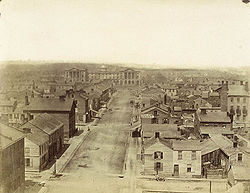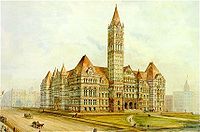- Old Toronto
-
This article is about the city of Toronto in 1834-1998. For the city of Toronto in 1793-1834, see York, Upper Canada.
Old Toronto — Dissolved municipality — One of the earliest photographs of Toronto 
Coat of arms
LogoNickname(s): Toronto the Good, Queen City, Hogtown Motto: Industry, Intelligence, Integrity City of Toronto before 1998 in red Coordinates: 43°39′09″N 79°22′54″W / 43.6525°N 79.38167°WCoordinates: 43°39′09″N 79°22′54″W / 43.6525°N 79.38167°W Country  Canada
CanadaProvince  Ontario
Ontario'Megacity'  Toronto
TorontoEstablished 1834 (City of Toronto) from Town of York Changed Region 1954  Metropolitan Toronto from York County
Metropolitan Toronto from York CountyAmalgamated 1 January 1998 into Toronto Government – Mayor List of mayors of Toronto – Governing Body Toronto City Council Area[1] – Total 97.15 km2 (37.5 sq mi) Population (2001)[1] – Total 676,352 – Density 6,961.9/km2 (18,031.2/sq mi) Time zone EST (UTC-5) – Summer (DST) EDT (UTC-4) Area code(s) 416, 647 Old Toronto is the retronym of the original portion of Toronto, Ontario, Canada. It was first incorporated as a city in 1834, after being known as the Town of York and became part of the region what was then known as York County. In 1954, it became part of Metropolitan Toronto. It expanded in size by annexation of surrounding municipalities, reaching its final boundaries in 1967. Finally, in 1998, it was amalgamated into the present-day "megacity" of Toronto.
Post-amalgamation, the area within the boundaries of the former city is variously referred to as the "former city of Toronto" or "Old Toronto". Historically, Old Toronto has referred to Toronto's boundaries before the Great Toronto Fire of 1904, when much of city's development was to the east of Yonge Street. The term "downtown core" is also sometimes used to refer to the district, which actually refers to the central business district of Toronto, which is located within the former city.
Old Toronto is the densest area in the entire Greater Toronto Area.
Contents
History
Part of the series on History of Toronto History Town of York (1793–1834) City of Toronto (1834–1954) Metropolitan Toronto (1954–1998) Toronto Megacity (1998–present) Events Toronto Purchase 1787 Battle of York 1813 Battle of Montgomery's Tavern 1837 First Great Fire of Toronto 1849 Second Great Fire of Toronto 1904 Hurricane Hazel (effects) 1954 First Amalgamation 1967 Second Amalgamation 1998 Other Etymology of 'Toronto' History of Neighbourhoods Oldest buildings and structures Timeline of Toronto history Toronto portal · The former town of York was incorporated on March 6, 1834, reverting to the name Toronto to distinguish it from New York City, as well as about a dozen other localities named 'York' in the province (including the county in which Toronto was situated), and to dissociate itself from the negative connotation of dirty Little York,[1] a common nickname for the town by its residents. The population was recorded in June 1834 at 9,252.[2]
William Lyon Mackenzie, a Reformer was its first mayor, a position he only held for one year, losing to Tory Robert Baldwin Sullivan in 1835.[3] Sullivan was replaced by another Tory, George Gurnett in 1837. That year, Toronto was the site of the key events of the Upper Canada Rebellion. Mackenzie would lead attacks on Toronto in November 1837. The attacks were ineffectual, but loyal militia in Toronto went out to the rebel camp at Montgomery's Tavern and dispersed the rebels. Mackenzie and other Reformers escaped to the United States, while some rebel leaders such as Samuel Lount and Peter Matthews were hanged. Toronto would elect a succession of Tory or Conservative mayors, and it was not until the 1850s that a Reform member would be mayor again.[4]
The earliest Toronto neighbourhoods were the five municipal wards that the city was split into in 1834. The wards were named for the patron saints of the four nations of the British Isles (St. George, St. Andrew, St. Patrick, and St. David) and St. Lawrence, the patron saint of Canada. Today, only St. Lawrence remains a well-known neighbourhood name. The others have attached their names to a variety of still existing landmarks including three subway stations. As Toronto grew, more wards were created, still named after prominent saints. St. James Ward is preserved in the modern St. James Town neighbourhood, while the northern ward of St. Paul's has continued to the present as a federal and provincial electoral district.
In 1834, Toronto was incorporated with the boundaries being Bathurst Street on the west, 400 yards north of Queen Street and Parliament Street on the east. Outside this formal boundary were the 'liberties', land pre-destined to be used for new wards. These boundaries were today's Dufferin Street to the west, Bloor Street to the north, the Don River to the east, with a section along the lake shore east of the Don, and south of today's Queen Street, to the approximate location of today's Maclean Street. The liberties became formally part of the city in 1859 and the wards were remapped.[5]
The boundaries of Toronto remained the same into the 1880s. Toronto expanded into the west by annexing Parkdale in 1889 and Brockton in 1884, and properties, such as High Park, west to Swansea by 1893. In the 1880s, Toronto expanded to the north, annexing Yorkville in 1883, the Annex in 1887, Seaton Village in 1888. In the 1900s, Toronto expanded again to the north, annexing Rosedale in 1905, Deer Park in 1908, West Toronto and Wychwood in 1909, Earlscourt in 1910, Moore Park and North Toronto in 1912. To the east, Toronto annexed Riverdale in 1884, a strip east of Greenwood in 1890, Midway in 1909, East Toronto in 1908 and an extension east to Victoria Park Avenue in 1909.[6] By 1908, the named wards were abolished, with a simple numbering scheme of Ward 1 to Ward 6.[5]
By the 1920s, Toronto stopped annexing suburbs. In 1954, the Metropolitan Toronto federation was formed, which included Toronto and numerous suburbs in a two-tier municipal government, and consolidating districts. In a 1967 reform of Metro Toronto, the suburbs of Swansea and Forest Hill were absorbed into Toronto as part of provincial legislation. This completed the City of Toronto's growth in area until the amalgamation of 1998.
Demographics
The population of Toronto was 676,352 as of the 2001 census, living on a land area of 97.15 km² (37.51 sq mi). The population was 70% White, 10% Chinese, 5% Black, 5% South Asian, 3% Filipino, 2% Latin American, 2% Southeast Asian, 1% Korean, and 2% Other.[7]
See also
References
- Bibliography
- Careless, J. M. S. (1984). Toronto to 1918. James Lorimer & Company. ISBN 0888626657.
- Notes
- ^ Firth, Edith G., ed (1966). The Town of York: 1815—1834; A Further Collection of Documents of Early Toronto. University of Toronto Press. pp. 297–298.
- ^ Careless, p. 54
- ^ Careless, p. 59
- ^ Careless, p. 60
- ^ a b Careless, p. 126
- ^ Careless, p. 125
- ^ "2001 Community profiles". Statistics Canada. http://www12.statcan.ca/english/Profil01/CP01/Details/Page.cfm?Lang=E&Geo1=CSD&Code1=3520004&Geo2=PR&Code2=35&Data=Count&SearchText=Toronto&SearchType=Begins&SearchPR=35&B1=All. Retrieved 2010-04-15.
Former municipalities of Toronto by year of amalgamation 1883-1912 1883: Yorkville · 1884: Brockton · Riverdale · 1888: Seaton Village · 1889: Parkdale · 1890: Bedford Park · Davisville · 1905: Rosedale · 1908: Deer Park · East Toronto · 1909: Bracondale · West Toronto · Wychwood · 1910: Moore Park · North Toronto · 1912: Dovercourt · Earlscourt1967 1998 Categories:- Populated places established in 1834
- Populated places disestablished in 1998
- Metropolitan Toronto
- Former municipalities in Toronto
- Neighbourhoods in Toronto
- Former cities in Canada
- History of Toronto
Wikimedia Foundation. 2010.



